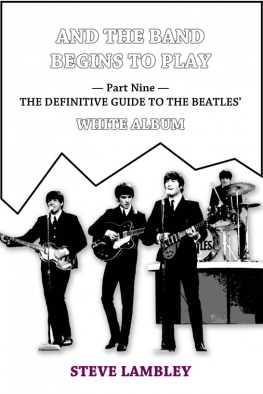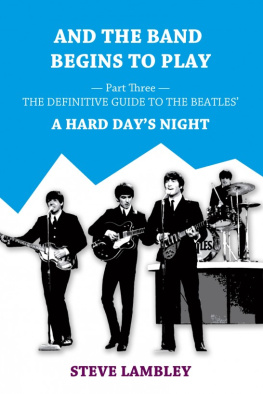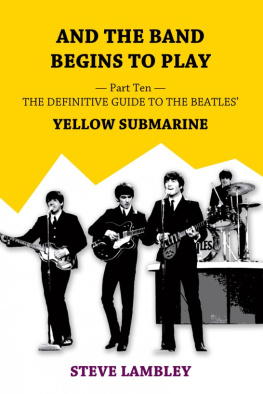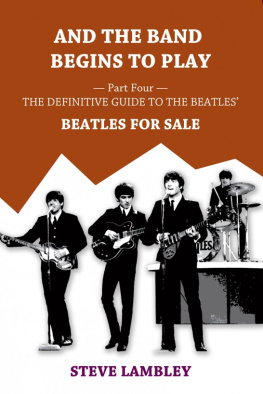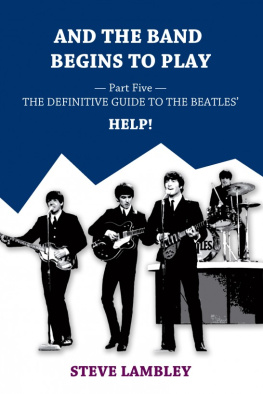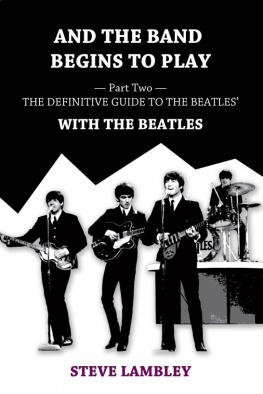AND THE BANDBEGINS TO PLAY
Part Seven The Definitive Guide to the Beatles REVOLVER
by
SteveLambley
Published bySLIDE Books
Version 2.0
Steve Lambley2015
All song lyricsremain the copyright of their respective owners, and are quoted forthe purposes of scholarship, under fair dealing and fair usagelaws. No infringement is intended.
No part of thisbook may be reproduced in any form without written permission fromthe copyright holder.
SmashwordsEdition, Licence Notes
This ebook islicensed for your personal enjoyment only. This ebook may not bere-sold or given away to other people. If you would like to sharethis book with another person, please purchase an additional copyfor each recipient. If youre reading this book and did notpurchase it, or it was not purchased for your use only, then pleasereturn to Smashwords.com and purchase your own copy. Thank you forrespecting the hard work of this author.
Table of Contents
Single release
Parlophone R 5452 Released 10 June 1966
Paperback Writer
[Lennon-McCartney]
Recorded 13, 14 April
Mixed 14 April (mono), 31 October (stereo)
Paul leadvocals, lead guitar, bass
John harmony and backing vocals, rhythm guitar
George harmony and backing vocals, tambourine
Ringo drums
Acharacteristic of most Beatles records to date is the relativeinaudibility of the bass. On Beatles For Sale, thearrangement of Words Of Love, which has a bass, sounds much likeIll Follow The Sun, which has none. On Not A Second Time thebass is mixed so low that many Beatles commentators assume thatPaul wasnt even present for the recording. Although this lack ofbass sound was also true for other artists recordings, it wassomething that had irked the Beatles for some time. The EMIcorporate explanation for keeping the bass sound low was to preventthe stylus jumping all over the place when the record was played.Naturally, as soon as the Beatles recording team could dosomething about the situation, they did.
On PaperbackWriter, Pauls Rickenbacker bass, used for many Rubber Soultracks, is pushed up front and recorded using a revolutionarytechnique. Geoff Emerick, who had been newly promoted to Engineeron the Beatles sessions, replacing Norman Smith, and who would beGeorge Martins right-hand man for many years to come, had hadexperience of the disc-cutting process. He knew that EMI would notpress copies of a million-selling record if there were any chanceit would give stylus-jumping problems. Emerick realised that theproblem of jumping could possibly be overcome by a bettermicrophone arrangement. At the time, of course, the instrumentswere recorded with microphones in front of their amplifier speakers until Sgt Pepper, there was no direct injection of thebass signal from the guitar into the mixing console. But perhaps amore even frequency response could be gained from a microphone witha larger diaphragm, which would therefore be responsive to lowerfrequencies.
I was gettingfrustrated listening to American records like the Motown stuffbecause the bass content was a lot stronger than we were putting onour records. We were governed by certain rules and regulations atAbbey Road, so I could never get the sound I really wanted on thebass. In desperation one day I figured that we could use aloudspeaker as a microphone it works the same way in reverse, soits effectively the same thing. That way the speaker could takethe weight of the air vibrations from a bass.
Therefore, withhelp from Ken Townsend (inventor of artificial double tracking, ofwhich more later), Emerick devised a system using a secondloudspeaker as a microphone. The studio had large playbackspeakers, so-called White Elephants (rightly named, accordingto Townsend, big and horrible!), for playing back recordedmaterial from the control room (where, at that stage, recordingartists feared to tread). By putting one of these in front ofPauls bass speaker, the cone of the White Elephant acted as a hugediaphragm. So the sound waves produced by Pauls bass amplifiercaused its cone to vibrate, which in turn produced the signal thatwas recorded on tape.
The actualdisc of Paperback Writer was cut using another new EMIdevelopment, the Automatic Transient Overload Control, or ATOC.This allowed a high level of bass, without the extreme peaks thatwere liable to send needles skipping over the record. The result ofthis combination of studio trickery is that not only is the bassprominent, but, as it comes thumping in after four bars of guitarand drums, it even acts as a lead instrument. The texture of thebass is certainly different to that of Day Tripper, which isactually the first single to play up the bass, since it was used toenhance the guitar riff. Although the Paperback Writer bass iswarm and rounded, the experiment isnt completely successful as thebass sound is missing an attacking edge and lacks some of the biteof the previous single. Technically, the problem with thearrangement was that the speaker acting as a microphone also pickedup a lot of extraneous noise from the building, and so had to befiltered, rather defeating the purpose.
Theintroduction to the track completes a trilogy of powerful butrelated guitar riffs that started with I Feel Fine, all threeowing a debt of gratitude to Bobby Parkers Watch Your Step from1961.
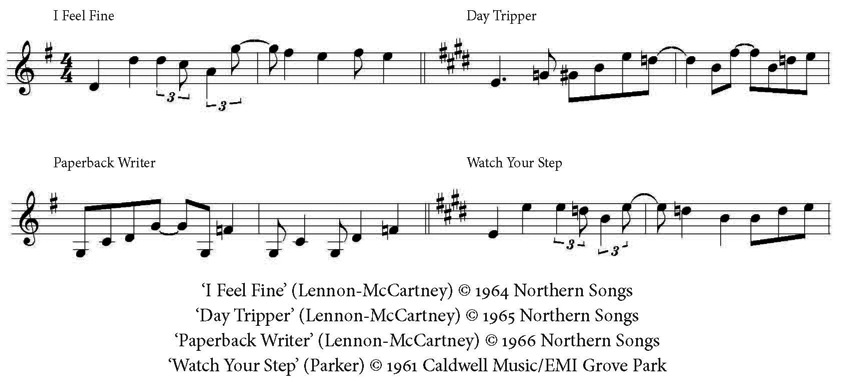
John calledPaperback Writer the son of Day Tripper, but it is Paulssong. With its flattened sevenths and double-time syncopation, theriff does have slightly more in common with Day Tripper than withI Feel Fine, but the three songs are clearly part of the samewhole. This time, however, the guitar figure follows a NowhereMan style a cappella introduction, and is kicked into gear by apre-emptive snare rap from Ringo.
The vocalintroduction was heavily influenced by the Beach Boys, who were inthe UK charts at the time with the single Barbara Ann. Theinterwoven paperback writers fill the air and in stereo, fillthe stereo spectrum repeated after each pair of verses, usinggaps in the tracks on the tape left by guitar, bass and drums.These vocal breaks are prefaced by phasing to give a fuller sound,and delayed tape echo to drag out the preceding phrase. The vocalsalso benefit from the aforementioned artificial double tracking,the first time the public were exposed to the new technique,although it had first been used for the recording of TomorrowNever Knows the previous week. Double tracking of vocals wasgetting to be a chore, time-consuming and often frustrating, butwholly necessary for a full and rounded vocal sound. In the monthssince Rubber Soul, Ken Townsend had obviously given thissome thought, and had developed a way of using electronic delaywhen mixing a track to produce a second vocal track, delayed by afew milliseconds. The vocal could therefore be treated with thisdelay and produce a double-tracked voice from a singlerecording.
So we haveBeach Boys-style harmonising treated to an Abbey Road-style vocaleffect. The striking, layered vocal is carefully plotted togradually produce dissonance, culminating in what is effectively Cmajor9 (or more accurately, an A minor11 but without the root) C,E, G, B, D an edgy chord that underlines the impatience of thelyric.

The backingvocals for the second half of the song are worth a second listen strange but true, John and George are actually singing the nurserysong Frre Jacques. Paul hit upon including this as the simplestof counterpoint lines midway through the second days recording,although whether it was included to invoke schoolday nostalgia isnot certain. The falsetto delivery and extended notes contrast wellwith the quick, sputtering melody. The engineering notes for thesession, reproduced in both of Mark Lewisohns chronicles, list arange of experiments tried on the overdubs to the song, includingfrequency control 38 k/c George John. The notes also speak oflimiters, compressors, jangle boxes through Leslie speakers byGeorge Martin, and putting Georges guitar in every gap afterpaperback writer. Although the structure of the finished song wasvery straightforward, much of the eleven and a half hours it tookto record was evidently taken up with experimenting with studioeffects. As Paul remarked at the time, the trouble is that wevedone everything we can with four people so its always a problem toring the changes and make it sound different.
Next page
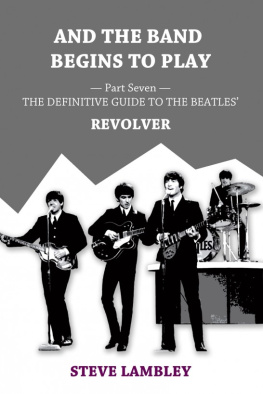
![Lambley - And the Band Begins to Play: [Part1 The Definitive Guide to the Beatles Please Please Me]](/uploads/posts/book/213741/thumbs/lambley-and-the-band-begins-to-play-part1-the.jpg)
![Lambley - And the Band Begins to Play: [Part9 The Definitive Guide to the Beatles White Album]](/uploads/posts/book/213743/thumbs/lambley-and-the-band-begins-to-play-part9-the.jpg)
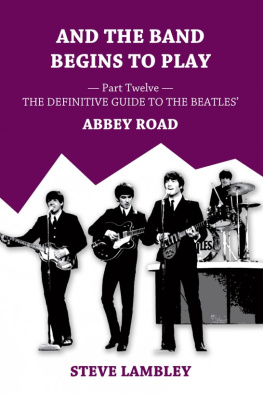


![Lambley - And the Band Begins to Play: [Part6 The Definitive Guide to the Beatles Rubber Soul]](/uploads/posts/book/213742/thumbs/lambley-and-the-band-begins-to-play-part6-the.jpg)
